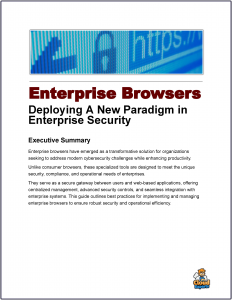Transforming the Digital Workplace with Enterprise Browsers
By focusing on collaboration and optimized business processes, enterprise browsers unlock new levels of productivity, transforming the way organizations function.
 In the feature video Gavin Lauchlan of Here introduces the concept of the Enterprise Browser, and how it enables a unified space for work that maximizes productivity and delivers exceptional employee experiences.
In the feature video Gavin Lauchlan of Here introduces the concept of the Enterprise Browser, and how it enables a unified space for work that maximizes productivity and delivers exceptional employee experiences.
And in this podcast the panel describe their adoption as ‘Work’s Natural Next Step’, discussing how enterprise browsers expand capabilities in asset management, security, and user experience.
The enterprise browser, a specialized tool designed to meet the unique demands of modern workplaces, is revolutionizing how businesses operate by fostering seamless collaboration and streamlining critical business processes.
Unlike traditional browsers built for general consumer use, enterprise browsers are tailored to enhance workplace efficiency, offering a unified platform that integrates with enterprise systems, simplifies workflows, and empowers teams to work together more effectively.
Secure Collaboration Foundation
Maximizing enterprise productivity can be achieved when organizations have a foundation of absolute security to build upon. When staff are empowered to work freely, within a defined construct, the IT team can be an enabler not a manager of their work environment.
Andrew Harding proposes that any browser can be a secure enterprise browser, describing their process for implementing the Secure Enterprise Browser, designed to protect modern enterprises from escalating cyber threats like phishing and malware. This targets widely used browsers, seamlessly integrating with browsers like Chrome and Edge.
The browser plays a critical role in enhancing productivity, securing data, and adopting AI safely. Microsoft Edge for Business is a secure enterprise browser optimized for AI: it’s designed to address the needs of the modern workforce, while providing secure access anywhere and on any device.
Digital Workplace Collaboration
At the heart of the enterprise browser’s impact on productivity is its ability to enhance collaboration across teams, regardless of location or device. In a world where remote and hybrid work models are increasingly common, employees need tools that enable real-time communication and seamless access to shared resources.
Enterprise browsers address this need by integrating directly with collaboration platforms like Microsoft Teams, Slack, or other enterprise-grade tools.
Employees can initiate video calls, share documents, or collaborate on projects without leaving the browser interface. This eliminates the need to toggle between multiple applications, reducing friction and allowing teams to stay focused on their tasks.
For example, a project manager can review a shared document, provide feedback, and discuss updates with team members in a single browser window, creating a fluid and efficient collaborative experience. By centralizing these interactions, enterprise browsers minimize disruptions and help teams achieve their goals faster.
Task and Process Automation
Beyond collaboration, enterprise browsers significantly enhance productivity by optimizing business processes. Many workplace tasks involve navigating complex software ecosystems, such as customer relationship management (CRM) systems, enterprise resource planning (ERP) platforms, or internal dashboards.
Enterprise browsers streamline these processes by offering single sign-on (SSO) capabilities, which eliminate the need for repeated logins across applications. This creates a seamless workflow where employees can access all necessary tools through one interface, saving valuable time.
Additionally, enterprise browsers often include automation features that simplify repetitive tasks, such as auto-filling forms or extracting data from web-based applications. For instance, a sales team member can quickly pull customer data from a CRM and generate a report without manual data entry, allowing them to focus on strategic activities like client engagement.
These streamlined processes reduce the time spent on administrative tasks, enabling employees to prioritize high-value work that drives business outcomes.
The combined effect of improved collaboration and optimized business processes directly translates to measurable productivity gains. By providing a unified platform that integrates communication tools and enterprise applications, enterprise browsers eliminate the inefficiencies of context-switching and fragmented workflows.
Teams can collaborate more effectively, share information instantly, and complete tasks with greater speed and accuracy. Moreover, the intuitive design of enterprise browsers ensures that employees can adopt these tools with minimal training, further reducing downtime and boosting engagement. For organizations, this means faster project delivery, improved decision-making, and a more agile workforce capable of adapting to evolving business needs.
Conclusion
In conclusion, the enterprise browser is a transformative tool that redefines productivity by fostering seamless collaboration and streamlining business processes. By integrating communication tools and enterprise applications into a single, user-friendly interface, it empowers teams to work together efficiently and execute tasks with precision.
As businesses navigate the complexities of modern work environments, adopting an enterprise browser is a strategic step toward unlocking the full potential of their workforce. This technology not only enhances productivity but also positions organizations to thrive in an increasingly dynamic and competitive landscape.



